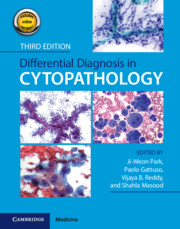Book contents
- Differential Diagnosis in Cytopathology
- Differential Diagnosis in Cytopathology
- Copyright page
- Dedication
- Contents
- Contributors
- Preface
- 1 The Pap Smear
- 2 Exfoliative Pulmonary Cytology
- 3 Body Cavity Fluids
- 4 Gastrointestinal Tract
- 5 Urinary Cytology
- 6 Cerebrospinal Fluid and Intraocular Cytology
- 7 Cytopathology of Central Nervous System
- 8 Fine-Needle Aspiration of Thyroid Gland
- 9 Parathyroid Gland, Head, and Neck
- 10 Salivary Glands
- 11 Cytopathology of the Breast
- 12 Fine-Needle Aspiration of Lymph Nodes
- 13 Fine-Needle Aspiration of Lung, Pleura, and Mediastinum
- 14 Fine-Needle Aspiration of Liver
- 15 Fine-Needle Aspiration of the Pancreas
- 16 Fine-Needle Aspiration of Soft Tissue and Bone
- 17 Fine-Needle Aspiration of the Kidney and Adrenal Gland
- 18 Cytology of the Gonads
- 19 Fine-Needle Aspiration Cytology of Tumors of Unknown Origin
- Index
- References
5 - Urinary Cytology
Published online by Cambridge University Press: 05 March 2021
- Differential Diagnosis in Cytopathology
- Differential Diagnosis in Cytopathology
- Copyright page
- Dedication
- Contents
- Contributors
- Preface
- 1 The Pap Smear
- 2 Exfoliative Pulmonary Cytology
- 3 Body Cavity Fluids
- 4 Gastrointestinal Tract
- 5 Urinary Cytology
- 6 Cerebrospinal Fluid and Intraocular Cytology
- 7 Cytopathology of Central Nervous System
- 8 Fine-Needle Aspiration of Thyroid Gland
- 9 Parathyroid Gland, Head, and Neck
- 10 Salivary Glands
- 11 Cytopathology of the Breast
- 12 Fine-Needle Aspiration of Lymph Nodes
- 13 Fine-Needle Aspiration of Lung, Pleura, and Mediastinum
- 14 Fine-Needle Aspiration of Liver
- 15 Fine-Needle Aspiration of the Pancreas
- 16 Fine-Needle Aspiration of Soft Tissue and Bone
- 17 Fine-Needle Aspiration of the Kidney and Adrenal Gland
- 18 Cytology of the Gonads
- 19 Fine-Needle Aspiration Cytology of Tumors of Unknown Origin
- Index
- References
Summary
Urine cytology specimens make up an important percentage of the nongynecologic case load in most cytopathology laboratories. This type of specimen has been labeled as “challenging” due to a lack of quantitative definition of adequacy, the subjective nature of “atypia”, marked degenerative changes seen especially in voided urine specimens, and the unrealistic expectation of making a low-grade urothelial carcinoma (LGUC) diagnosis.
- Type
- Chapter
- Information
- Differential Diagnosis in Cytopathology , pp. 160 - 179Publisher: Cambridge University PressPrint publication year: 2021



